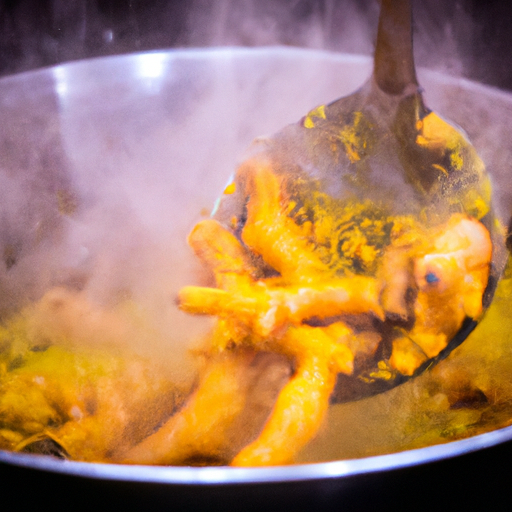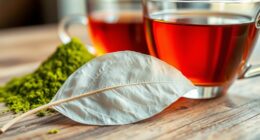Did you realize that about 80% of women suffer from menstrual cramps? This is a significant statistic and if you are one of those women, you understand just how painful and incapacitating these cramps can be.
The good news is that there are natural remedies that can help alleviate the pain, and one of the most effective is drinking tea. As a woman, I understand the discomfort and frustration that come with menstrual cramps. Over the years, I’ve tried various remedies, and I’ve found that drinking tea is one of the best ways to ease the pain.
Not only is tea a natural and safe option, but it also has numerous health benefits. In this article, I’ll be discussing the best types of tea for menstrual cramps and how they can help alleviate your discomfort. So, grab a cup of tea, and let’s get started!
Key Takeaways
- Drinking tea can help alleviate the pain of menstrual cramps, and certain types of tea have specific properties that can be particularly effective.
- Chamomile tea and ginger tea are two of the most effective teas for reducing menstrual cramps due to their anti-inflammatory and muscle-relaxant properties.
- Red raspberry leaf tea and cinnamon tea are other herbal remedies that can serve as effective uterine tonics to ease period cramps and promote hormonal balance.
- Consulting with a healthcare professional is always a good idea before adding any new supplements or remedies to a routine, as they can provide insight into which teas may be more effective for specific symptoms and monitor progress and adjust treatment plans as needed.
Understanding Menstrual Cramps
If you’re wondering why those pesky menstrual cramps are bothering you, it’s because your uterus is contracting to shed its lining. These contractions are caused by the release of prostaglandins, hormone-like substances that cause inflammation and pain. The higher the level of prostaglandins in your body, the more painful your menstrual cramps can be.
Other causes of menstrual cramps include endometriosis, fibroids, and pelvic inflammatory disease.
Luckily, there are many home remedies for menstrual cramps that can help alleviate the pain. Applying heat to your lower abdomen or taking a warm bath can help relax your muscles and reduce cramping. Massaging the affected area can also help relieve tension and improve blood flow.
Additionally, exercise, relaxation techniques, and over-the-counter pain medications can also be effective in reducing menstrual cramps. Now, let’s talk about the benefits of drinking tea for menstrual cramps.
Benefits of Drinking Tea for Menstrual Cramps
You’ll find relief from the discomfort of your monthly cycle by sipping on warm, comforting beverages that ease the ache and soothe the tension in your lower abdomen. Drinking tea is an excellent way to do just that, as it offers many health benefits that can help you manage your period cramps.
Here are four tea varieties that can help you find relief:
-
Ginger tea: Ginger is a natural anti-inflammatory agent that can help soothe menstrual cramps. Drinking ginger tea may also help reduce nausea and improve digestion during your period.
-
Peppermint tea: Peppermint is a natural muscle relaxant that can help ease the tension in your lower abdomen and reduce the severity of your cramps. It may also help reduce bloating and improve digestion.
-
Chamomile tea: Chamomile is a natural sedative that can help you relax and reduce stress during your period. It may also help reduce inflammation and improve sleep quality.
-
Raspberry leaf tea: Raspberry leaf contains compounds that can help regulate your menstrual cycle and reduce the severity of your cramps. It may also help strengthen your uterus and improve blood flow to your pelvic area.
Drinking tea can be a great way to manage your period cramps, and chamomile tea’s particularly effective.
Chamomile Tea
Relax and soothe your menstrual discomfort with the calming benefits of chamomile tea. Chamomile has long been used for its anti-inflammatory and antispasmodic properties, making it an effective remedy for menstrual cramps.
Not only can chamomile tea reduce pain and discomfort, it can also improve sleep quality and reduce stress levels, which are often heightened during menstruation. If you’re not a fan of chamomile tea, there are alternatives that can also offer relief.
For example, peppermint tea can help relax the muscles in the uterus and ease cramping. Additionally, raspberry leaf tea can strengthen the uterus and reduce menstrual pain. When brewing chamomile tea, be sure to use hot but not boiling water to preserve its beneficial compounds.
Steep for 5-10 minutes before drinking, and feel free to add a splash of honey or lemon for added flavor and soothing benefits. Transitioning into the subsequent section about ginger tea, another great option for menstrual cramps, it’s important to note that ginger tea can also help reduce inflammation and pain.
In the next section, we’ll explore the benefits of ginger tea and how to incorporate it into your menstrual relief routine.
Ginger Tea
Spice up your menstrual relief routine with the fiery benefits of ginger that can ignite a flame of relief in your body. Ginger tea has been used for centuries to alleviate menstrual cramps due to its anti-inflammatory and pain-relieving properties. It contains compounds like gingerols and shogaols that help to reduce inflammation and pain in the body.
But the health benefits of ginger tea don’t stop there. It can also aid in digestion, reduce nausea, and boost your immune system. To prepare ginger tea, simply slice a few pieces of fresh ginger root and steep them in boiling water for 10-15 minutes. You can add honey or lemon to taste.
Drinking ginger tea regularly can help alleviate menstrual cramps and provide a natural and soothing relief for your body.
Transitioning into the next subtopic, peppermint tea is another great option for menstrual cramps. Its natural anti-spasmodic properties can help to relax the muscles in the uterus and alleviate pain.
Let’s explore the benefits and preparation tips for this refreshing tea.
Peppermint Tea
As someone who’s dealt with painful menstrual cramps, I know how important it is to find effective remedies. That’s why I want to discuss peppermint tea as a potential solution.
Peppermint tea has been shown to help with muscle relaxation and has antispasmodic effects, making it a great choice for easing period cramps.
Muscle Relaxation
You’ll find relief from menstrual cramps with a warm cup of chamomile tea, which can help soothe your muscles and ease tension. Here are four ways chamomile tea can help alleviate your period cramps:
-
Muscle relaxation: Chamomile tea contains compounds that act as muscle relaxants, helping to ease muscular tension and reduce cramping.
-
Anti-inflammatory properties: Chamomile tea has anti-inflammatory properties that can help reduce pain and inflammation associated with menstrual cramps.
-
Reduces anxiety and stress: Chamomile tea has a calming effect on the body, which can help reduce anxiety and stress levels, both of which can exacerbate period cramps.
-
Promotes restful sleep: Chamomile tea contains a compound called apigenin, which has been shown to promote restful sleep. Getting enough sleep is important for overall health and can also help reduce menstrual cramps.
By incorporating stretching exercises and using a hot compress, you can further enhance the muscle relaxation benefits of chamomile tea.
Next, let’s explore how chamomile tea’s antispasmodic effects can also help alleviate period cramps.
Antispasmodic Effects
If you’re tired of feeling like your body is in knots during your monthly cycle, herbal remedies can be a great way to ease the discomfort.
Chamomile, in particular, has antispasmodic effects that can be a game changer. It helps ease muscle tension and cramping, which is a common issue during menstruation.
Chamomile is a natural remedy that can be consumed in many different ways. You can make a cup of chamomile tea, add chamomile essential oil to your bath, or even apply chamomile-infused cream to your lower abdomen. It’s an effective way to soothe your body and ease the pain of menstrual cramps.
Another herbal remedy that can be helpful during menstruation is red raspberry leaf tea, which we’ll discuss in the next section.
Red Raspberry Leaf Tea
I’d like to talk about Red Raspberry Leaf Tea, which is often recommended as a uterine tonic for menstrual cramps and other reproductive issues.
This tea is believed to help promote hormonal balance and regulate periods, making it a popular choice for women looking for natural remedies.
As someone who’s experienced painful menstrual cramps, I understand how frustrating it can be to find relief.
I hope this discussion can provide some helpful information.
Uterine Tonic
Let’s explore some teas that can serve as an effective uterine tonic to ease those pesky period cramps. As someone who suffers from cramps every month, I understand how debilitating they can be. Fortunately, there are herbal remedies that have been used for centuries in traditional medicine to help alleviate these symptoms.
One option is chamomile tea, which has anti-inflammatory properties that can help reduce pain and discomfort. Another option is cinnamon tea, which can help regulate blood flow and reduce cramping. Both of these teas are easy to find and can be a great addition to your monthly routine.
Remember to always consult with your healthcare provider before trying any new remedies, especially if you have any underlying medical conditions.
Now, let’s transition into the subsequent section about hormonal balance. It’s important to understand that period cramps can be caused by a variety of factors, including hormonal imbalances. By incorporating certain teas and other lifestyle changes, we can work towards achieving a better balance within our bodies and hopefully reduce the severity of our monthly symptoms.
Hormonal Balance
You can achieve a better balance within your body by incorporating certain lifestyle changes that work towards regulating your hormones. One of the most important aspects of hormonal balance is nutrition. Eating a balanced diet rich in vitamins and minerals can help regulate your menstrual cycle and alleviate period cramps. Incorporating foods like leafy greens, fruits, whole grains, and lean proteins can help provide your body with the nutrients it needs to regulate hormones and reduce inflammation. Additionally, drinking plenty of water and avoiding processed foods can also contribute to a healthier hormonal balance.
Exercise is another important factor in regulating hormones and reducing period cramps. Engaging in regular physical activity can help reduce stress and increase endorphins, which can help alleviate menstrual pain. Incorporating exercises like yoga, Pilates, and strength training can help improve blood flow, reduce inflammation, and alleviate period cramps. However, it is important not to over-exert yourself during your period and to listen to your body’s needs.
| Nutrition tips | Exercise routines |
|---|---|
| Eat a balanced diet rich in vitamins and minerals | Engage in regular physical activity |
| Incorporate foods like leafy greens, fruits, whole grains, and lean proteins | Practice exercises like yoga, Pilates, and strength training |
| Drink plenty of water and avoid processed foods | Listen to your body’s needs and avoid over-exertion during your period |
| Regulate your menstrual cycle and alleviate period cramps | Reduce stress and increase endorphins |
| Provide your body with the nutrients it needs to regulate hormones and reduce inflammation | Improve blood flow and reduce inflammation |
Incorporating these lifestyle changes can help achieve a better hormonal balance and alleviate period cramps. However, there are also natural remedies, like fennel tea, that can provide relief during menstruation.
Fennel Tea
If you’re looking for a natural remedy to alleviate period cramps, fennel tea may be just what you need. Fennel tea has been used for centuries for its medicinal properties, especially for its ability to soothe digestive issues.
Fennel tea benefits include reducing bloating, relieving constipation, and improving digestion. It is also rich in antioxidants and anti-inflammatory compounds, which can help reduce inflammation and pain associated with menstrual cramps.
To brew the perfect cup of fennel tea, start by bringing water to a boil and adding fennel seeds to the pot. Let the seeds steep for five to ten minutes, depending on how strong you like your tea. You can also add honey or lemon to taste.
Drinking fennel tea regularly can also help regulate hormones and improve overall hormonal balance, which can help reduce the severity of menstrual cramps over time. So, if you’re looking for a natural way to alleviate period cramps, try incorporating fennel tea for digestion into your daily routine.
Speaking of natural remedies, cinnamon tea is another great option for relieving period cramps.
Cinnamon Tea
When experiencing discomfort during menstruation, brewing a cup of cinnamon tea can be a great way to find relief. Aside from its sweet and spicy taste, cinnamon is known for its health benefits, such as reducing inflammation and improving blood circulation. These properties make it an excellent choice for easing period cramps and other menstrual discomforts.
To brew cinnamon tea, start by boiling water and adding a cinnamon stick or a teaspoon of ground cinnamon. Let it steep for 10-15 minutes, then strain and enjoy. Some people like to add honey or lemon to enhance the flavor, but it’s entirely optional.
Remember to avoid drinking too much cinnamon tea, as it can cause nausea or liver damage in large amounts. Overall, cinnamon tea is a natural and delicious way to alleviate period cramps and make your period more manageable.
Transitioning into the subsequent section about ‘lemon balm tea,’ another popular tea for menstrual cramps, it’s essential to note that lemon balm has a calming effect on the body and mind. Let’s explore this further in the next paragraph.
Lemon Balm Tea
I’ve found that drinking Lemon Balm tea can be very helpful for relaxation and calming effects, especially during times of stress or anxiety.
It’s also been shown to have anti-inflammatory properties, which can be beneficial for reducing pain and inflammation in the body.
Overall, I highly recommend trying Lemon Balm tea as a natural way to promote relaxation and support overall wellness.
Relaxation and Calming Effects
You’ll be happy to know that drinking chamomile tea can provide relaxation and calming effects during your period cramps. Chamomile tea has been used for centuries as a natural remedy for stress relief and as a sleep aid. These benefits can also help alleviate the discomfort and pain associated with menstrual cramps.
To further understand the benefits of chamomile tea, take a look at the table below. It highlights the key components found in chamomile, which contribute to its calming effects. The flavonoids found in chamomile have been shown to have anti-inflammatory properties, making it a great option for reducing period cramp pain. So, next time you’re experiencing menstrual cramps, brew a cup of chamomile tea to not only relax and calm your mind, but also soothe your body.
| Component | Benefit |
|---|---|
| Flavonoids | Anti-inflammatory |
| Apigenin | Anxiolytic |
| Quercetin | Antioxidant |
| Matricin | Anti-spasmodic |
Transitioning into the subsequent section, it’s important to note that while chamomile tea can help alleviate period cramp pain, there are other teas that have additional benefits. One of these is ginger tea, which has strong anti-inflammatory properties and can be particularly effective for reducing menstrual cramps.
Anti-inflammatory Properties
Ginger has potent anti-inflammatory properties, making it a valuable option for alleviating discomfort associated with menstrual pain. Studies have shown that ginger can effectively reduce inflammation and pain in the body due to its active ingredient, gingerol, which inhibits the production of certain chemicals in the body that cause inflammation.
In addition to ginger, there are many other herbal remedies known for their anti-inflammatory properties that can be used to relieve menstrual pain. Alternative medicine has long recognized the healing power of herbs and natural remedies. There are a variety of teas that can be brewed to provide relief during menstruation, such as chamomile, peppermint, or others. Therefore, when choosing the right tea, it is important to consider personal preferences as well as the specific benefits of each herb.
By incorporating herbal remedies into a menstrual care routine, individuals can tap into the natural healing power of plants and alleviate discomfort in a gentle and effective way.
Choosing the Right Tea for You
When it comes to choosing the right tea for period cramps, it’s important to consider your personal preferences. Do you prefer a certain flavor or type of tea?
Additionally, it’s always a good idea to consult with a healthcare professional before adding any new supplements or remedies to your routine. They can provide personalized recommendations based on your individual health needs.
Personal Preferences
If you’re like most people, you probably have a favorite tea that helps ease your period cramps. When it comes to choosing the best tea for menstrual discomfort, personal preferences play a significant role.
Tea preferences and taste preferences vary from person to person, and what works for one person may not work for another. Personally, I prefer ginger tea during my period. Ginger has natural anti-inflammatory properties that help to reduce pain and cramping. Additionally, the spicy kick that ginger provides gives me a comforting feeling during period discomfort.
However, everyone’s taste buds are different, and some people may prefer a more calming tea, such as chamomile or lavender. It’s important to experiment with different teas to find the one that works best for you.
Consulting a healthcare professional can also provide insight into which teas may be more effective for your specific symptoms. It’s always a good idea to check with a doctor or a licensed herbalist before trying new remedies, especially if you have any underlying health conditions or are taking medication. Their expertise can help guide you towards the best tea for your needs.
Consulting a Healthcare Professional
Talking to a healthcare professional can be like a compass guiding you through the fog of menstrual discomfort. It’s important to consult with a healthcare professional to ensure that the tea is safe and effective for your individual needs when looking for the best tea for period cramps. Here are three reasons why seeking healthcare accessibility and doctor recommendations can make a difference in managing menstrual pain:
-
Healthcare accessibility: A healthcare professional can provide valuable insights and advice on how to alleviate menstrual discomfort through a variety of methods, including tea. They can also recommend specific teas that are safe for you to consume and may even offer additional treatment options to manage your symptoms.
-
Doctor recommendations: A healthcare professional can recommend teas that are specifically tailored to your needs and medical history. They can also suggest teas with anti-inflammatory properties that can help ease cramps and discomfort. Additionally, your doctor can monitor your progress and adjust your treatment plan as needed.
-
Safe and effective treatment: By consulting with a healthcare professional, you can ensure that the tea you choose is both safe and effective for managing your period cramps. This can provide peace of mind and help you feel more in control of your menstrual health.
So, don’t hesitate to reach out to a healthcare professional for guidance on finding the best tea for your period cramps.
Frequently Asked Questions
Are there any teas that should be avoided during menstruation?
As someone who loves tea, I understand concerns about which ones to avoid during menstruation. While some teas can affect hormone levels, there are plenty of herbal alternatives to enjoy. It’s important to do your research and consult with a healthcare professional.
How often should I drink tea for menstrual cramps?
To alleviate menstrual cramps, I recommend drinking tea 2-3 times a day, starting a few days before your period. Drinking tea during your period can also help. The best time is when you feel discomfort.
Can tea completely alleviate menstrual cramps?
Menstrual cramps can be debilitating. I have found exploring alternative remedies to be helpful. Understanding the science behind cramps can also aid in finding relief. While tea may not completely alleviate cramps, it can offer soothing comfort.
Are there any potential side effects of drinking tea for menstrual cramps?
As with any medication or supplement, there are potential risks and interactions with medications when drinking tea for menstrual cramps. It’s important to consult with a healthcare provider before incorporating tea into your treatment plan.
Can I add sweeteners or milk to my tea for menstrual cramps, or will that lessen its effectiveness?
Yes, you can add sweeteners or milk to your tea for menstrual cramps without lessening its effectiveness. Honey and cinnamon can provide additional benefits. Almond or coconut milk can be a good option for those with lactose intolerance.
Conclusion
So, there you have it, folks. Drinking tea can be a natural and effective way to alleviate menstrual cramps.
From the soothing and calming effects of chamomile tea to the anti-inflammatory properties of ginger tea, there are many options to choose from.
As a woman who’s experienced her fair share of menstrual cramps, I understand the discomfort and pain that comes with it. But with the right tea, you can ease those cramps and feel a sense of relief.
So, go ahead and try out different teas to see what works best for you. Your body will thank you for it.
Remember, a warm cup of tea can be a comforting and healing experience, especially during those monthly visits from Aunt Flo.










